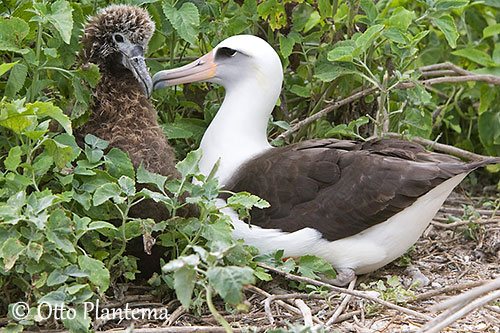
Text by Nicole Bouglouan
Photographers :
John Anderson
John Anderson Photo Galleries
Tom Grey
Tom Grey's Bird Pictures
Patrick Ingremeau
TAMANDUA
Tom Merigan
Tom Merigan’s Photo Galleries
Otto Plantema
Trips around the world
Simon Tan
PBase Bird galleries
Ingo Waschkies
Bird Photography
Sources:
HANDBOOK OF THE BIRDS OF THE WORLD vol 1 by Josep del Hoyo-Andrew Elliot-Jordi Sargatal - Lynx Edicions - ISBN: 8487334105
THE HANDBOOK OF BIRD IDENTIFICATION FOR EUROPE AND THE WESTERN PALEARCTIC by Mark Beaman, Steve Madge - C. Helm - ISBN: 0713639601
L’ENCYCLOPEDIE MONDIALE DES OISEAUX - Dr Christopher M. Perrins - BORDAS - ISBN: 2040185607
Around the World for Albatrosses – Where to see all the albatross species – Text and photo’s: Otto Plantema – Printed in 2019 – Lay out: Henry Meulman and Otto Plantema – 148 pages
(Revenues from this book will granted to the Albatross Task Force)
A Complete Guide to Antarctic Wildlife by Hadoram Shirihai and Illustrated by Brett Jarrett - Edited by Guy M. Kirwan - ALUL.A Press Oy, Finland - ISBN 9519894705
Wisdom the Albatross, the world's oldest breeding bird, to become a mother for the 37th time at 68
BirdLife International (BirdLife International)
Wikipedia, the free encyclopaedia
CREAGUS@Monterey Bay (Don Roberson)
Te Ara – The Encyclopedia of New Zealand
Laysan Albatrosses’ Plastic Problem
FAMILY DIOMEDEIDAE
Order Procellariiformes
Albatrosses
The family Diomedeidae currently includes 21 species in four genera, Diomedea, Thalassarche, Phoebastria and Phoebetria. The albatrosses are among the largest of flying bird species and are powerful fliers. Their courtship displays are spectacular with elaborate rituals. They are usually colonial nesters and some colonies show high nest density.
They have a long lifespan and most species can live up to 60 years. The world’s oldest known wild bird is a Laysan Albatross, named Wisdom. She is 74 years old and she regularly returns to the Midway Atoll National Wildlife Refuge in the Pacific. This year again, at the end of November, she joined her mate that was waiting for her because these birds have long-term pair-bonds, and she is now expecting another chick.

Phoebastria immutabilis
The largest albatrosses are placed in the genus Diomedea and include six species. Their wingspan may reach up to 350 centimetres and they can weigh between 6 and 11 kg. They range across the Southern Ocean and most of them nest on isolated oceanic islands.
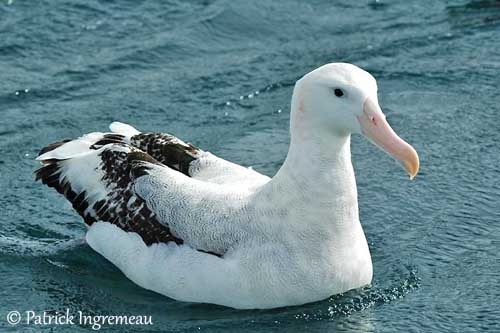
Diomedea exulans
The mollymawks of genus Thalassarche include nine species and are restricted to the Southern Hemisphere. They are medium-sized albatrosses with a wingspan of up to 250 centimetres and a weight ranging between 2400 and 5000 grams.
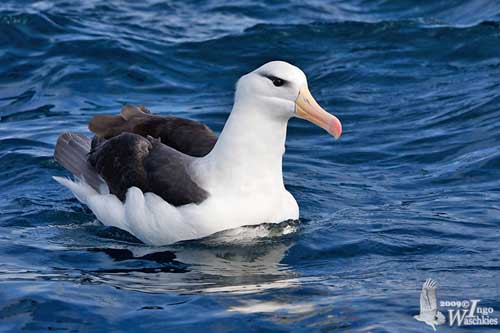
Thalassarche melanophris
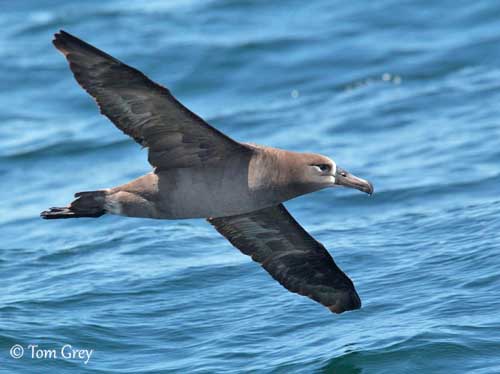
Phoebastria nigriceps
The sooty albatrosses of genus Phoebetria range across the Southern Ocean from S America to Australia and breed on sub-Antarctic islands. There are two dark species with a wingspan between 185 and 220 centimetres and a weight of 2400-3100 grams.

Phoebetria palpebrata
Albatrosses have rather compact body with large head and strong neck, long, narrow wings and short, rounded tail. The strong legs are short and allow the birds to walk or stand on land. While walking, they sway from side to side. The Waved Albatross has included an adapted and exaggerated similar movement to its courtship displays. The large webbed feet are used for swimming and can propel the albatrosses along the surface, even in very rough seas.
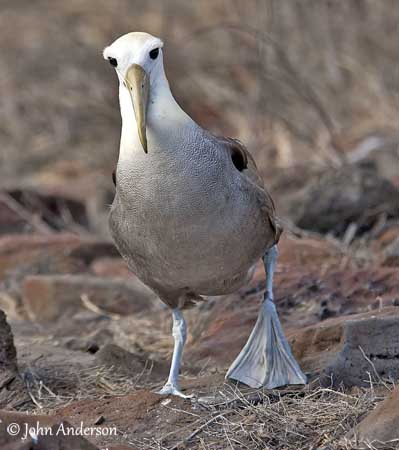
Phoebastria irrorata
The large, hooked bill is made of several horny plates. According to the species, the bill is pinkish or dark, or with bright coloured markings. The tubular nostrils are external, placed high on each side of the upper mandible, and give the birds a good sense of smell. The salt glands above each eye filter the excess salt excreted through the bill. All albatrosses have a distinctive musty smell, due to the stomach oil.
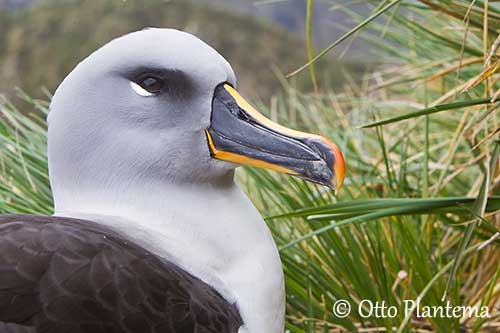
Thalassarche chrysostoma
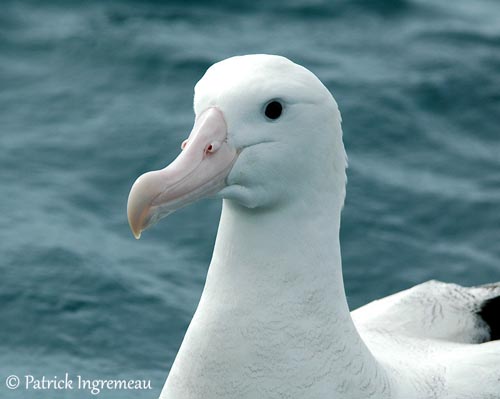
Diomedea exulans
Albatrosses of genus Diomedea usually have dark upperwing and tail. The underparts are paler, often variably white in adult plumage. The Amsterdam Albatross (D. amsterdamensis) has dark upperparts while other Diomedea species have white body. The head is white, with dark crown and hindneck according to the species. The bill is pinkish and the eyes are dark.
In the genus Thalassarche, albatrosses have coloured markings on the face such as eye patches, or grey or yellow tinge on head and hindneck. In several species, the bill is dark with yellow-coloured culmen, whereas some others have pale pink-orange or pale grey to yellowish bill.
Diomedea sanfordi

Thalassarche eremita
The species of genus Phoebastria are slightly darker, and the Black-footed Albatross (Phoebastria nigriceps) is entirely sooty brown included head and bill. The Waved Albatross (Phoebastria irrorata) has dark upperparts but whitish head and tail, whereas the Laysan Albatross (Phoebastria immutabilis) and the Short-tailed Albatross (Phoebastria albatrus) have black-and-white plumage, respectively with grey face or yellowish tinge on the head.
The two albatrosses of genus Phoebetria have dark sooty brown plumage overall, including head and bill, and a narrow white eyering.
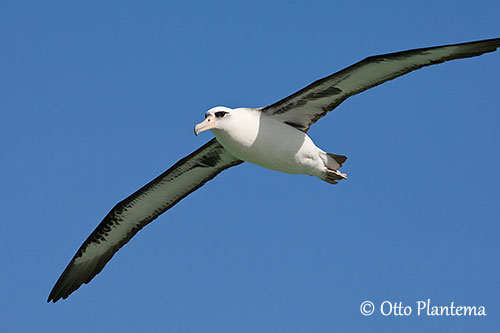
Phoebastria immutabilis
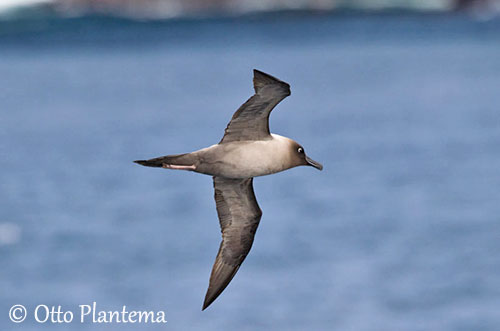
Phoebetria palpebrata
The immatures have duller colours on head and bill, although they are similar to adults in Laysan and Waved Albatrosses.
They have a long sequence of various intermediate plumages with first a mostly dark plumage, becoming gradually white on body, head and wings according to the species.
All species always retain the dark coloration of the flight feathers, because dark feathers with high melanin content are more resistant to abrasion than pale coloured feathers. As these birds have to cover great distances for foraging, they need strong feathers structure. These feathers are moulted almost entirely at sea, but more information is required.
Albatrosses are large flying birds with long, narrow wings allowing them a good manoeuvrability in the air. Only the wildest storms can keep them down on the water. But in contrast, calm weather leaves them stranded on the water or on land because they are unable to take off. In flight, they glide along on stiff wings, rising and falling, taking advantage of the wind speeds at different heights. They can travel long distances by dynamic soaring, using the wind to keep the speed with a low expenditure of energy.
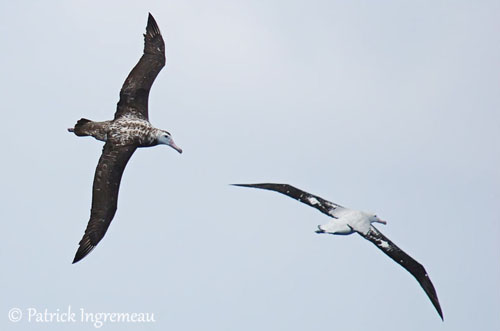
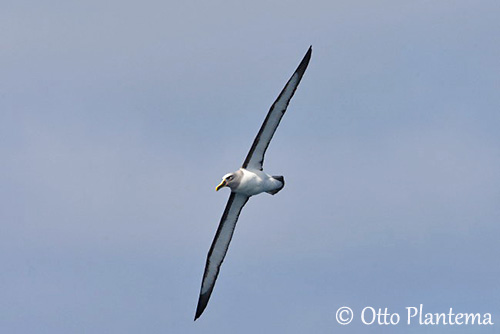
Thalassarche bulleri
The take-off from the water needs a short run, facing into the wind with spread wings to become airborne. Then, after a few wingbeats, it normally takes off. The landing is another difficult manoeuvre and collisions may occur with humans and aircrafts, the most frequent unforeseen obstacles between the bird and its landing place. Finally, landing on water seems to be less complicated or dangerous.
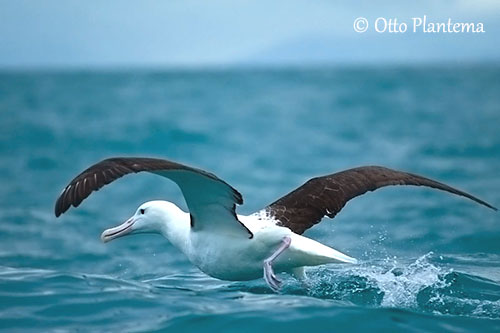
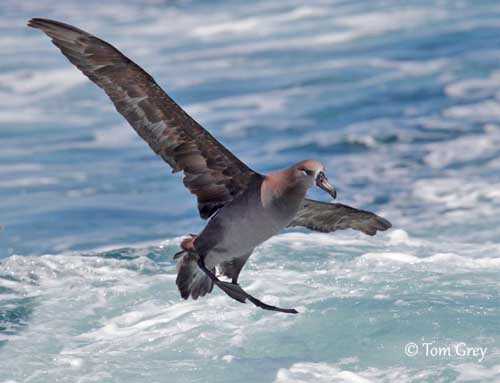
The members of the family Diomedeidae feed primarily on squid, fish, crustaceans and floating carrion. But the diet depends on species, range and season. Many species depend heavily on squid taken at water surface, when the shoals migrate vertically by night. A wide range of fish includes lampreys, small flying-fish, pilchards and rockfish, varying with the range. Albatrosses feed heavily on krill of genus Euphausia too, but other crustaceans are also taken.
They also feed on algae, sea urchins, fish spawn, medusae and barnacles. The Sooty Albatross (Phoebetria fusca) feeds on floating carrion, usually pieces of dead seabirds and penguins.
They often get food from the fishing boats such as scraps thrown overboard, and occasionally follow the cetaceans, enjoying the disturbed preys.
They are usually silent at sea, but when competing for food while following the fishing boats, they give croaking, shrieking or gargling sounds.

Phoebastria nigriceps
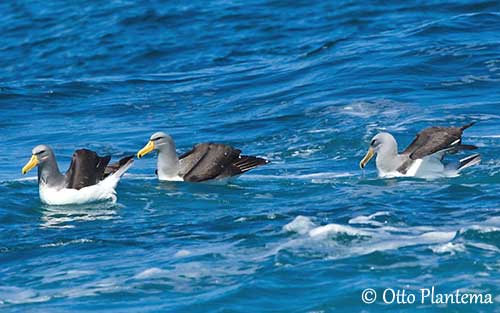
Thalassarche eremita
They often catch their preys by surface-seizing while sitting on the water, as the largest albatrosses cannot manoeuvre on the wing, and only the most agile fliers can seize the food at the surface in flight. The smaller albatrosses are able to make shallow plunges about a metre underwater, like the Wandering Albatross (Diomedea exulans) does too, in spite of its large size. On the other hand, the Black-browed Albatross (Thalassarche melanophris) can swim underwater, about five metres down. The Light-mantled Albatross (Phoebetria palpebrata) can dive as deep as 12 metres. From some observations, they also perform plunge-diving from the air to catch a prey. The Waved Albatross (Phoebastria irrorata) performs kleptoparasitism and attacks the Sulidae, forcing them to release their recently caught preys.
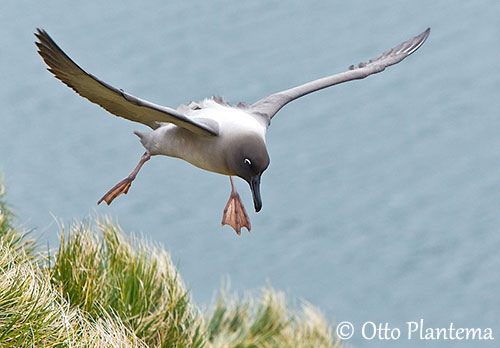
Phoebetria palpebrata
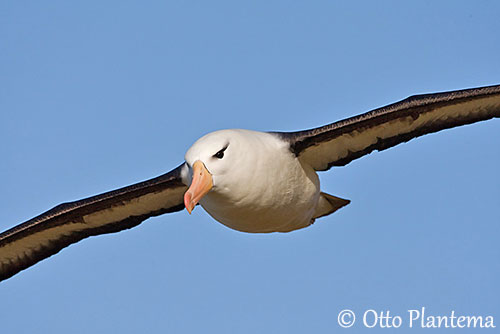
Thalassarche melanophris
Many species occur in the high latitudes of the Southern Hemisphere where the strong winds are ideal for their flying technique. They forage far from land, including during the breeding season.
These birds come on land only for breeding and spend most of time at sea. They can wander thousands of kilometres on the high seas. However, some species such as the Black-browed Albatross, the Black-footed Albatross and the Waved Albatross are known to come regularly near coastal waters, attracted by good feeding areas.
The breeding colonies are often established on isolated islands. Some of them have bare ground, others have grassy ledges in cliffs or stony slopes, and some areas are covered with bushy vegetation. Boulders and sandy beaches can be used too.
The albatrosses nest on the ground.
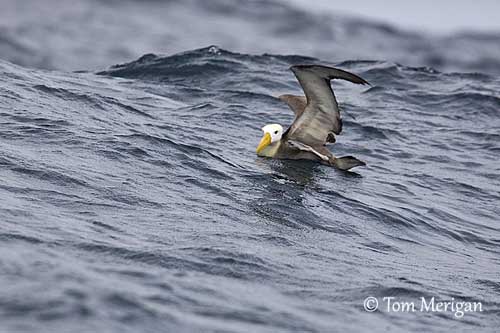
Phoebastria irrorata
They have a long breeding cycle over a full year, and when breeding success occurs, they only breed every two years. They are sexually mature between 6 and 10 years old. They breed in huge colonies. Laysan and Black-browed Albatrosses can form colonies of about 100,000 pairs. The nests are usually well spaced out, from 1,30 to 4 metres according to the size of the species. For this reason, interactions between each other are lower than in other seabird species.
At the beginning of the cycle, the nest-site is defended by bill-snapping at intruders. Several ritualized postures are used in territorial behaviour, in order to advertise the status to the intruders. A few weeks later, this behaviour almost disappears, although an intruder passing close to a sitting bird will be pecked at.

Phoebastria immutabilis
The albatrosses are monogamous with long-term pair-bonds, and generally pair for life. The wide repertoire of courtship displays is used for pair formation. Several stereotyped postures are performed over and over again. They include bill-circling, sky-pointing, and flank-touching with the bill. The Waved Albatross is known for its exaggerated head-swaying walk. The great albatrosses spread largely their wings while facing each other and calling. We can hear throaty calls, groans, grunts and moans during the displays which can sometimes occur at sea. Occasionally, several birds including pairs in the process of formation but also loose birds, may perform a communal dancing.
The already mated pairs do not perform elaborate displays. Once the mates meet again at the nest-site, only a few greeting ceremonies occur.
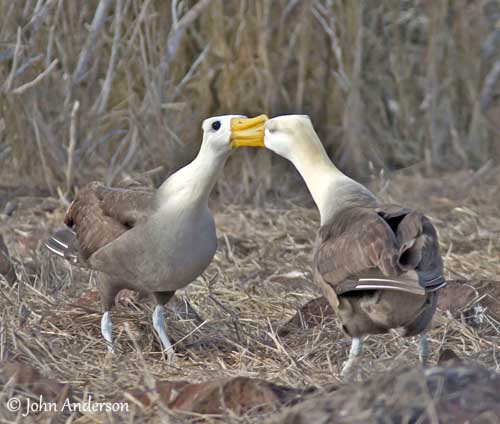
Phoebastria irrorata
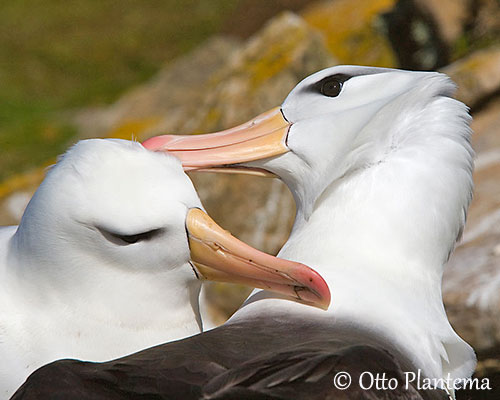
Thalassarche melanophris
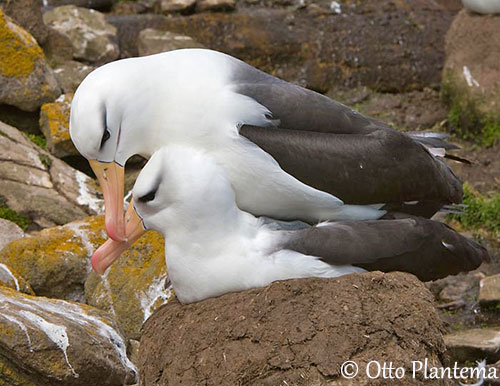
Thalassarche melanophris
After the copulation at the nest-site, both mates go back to the sea for feeding and build up reserves for making the egg, and for the male to start the long incubation.
The nest is often used for several following years. The truncated cone is made with mud, grass and moss. There is a shallow depression on top. According to the species and the location, the nest may be 15-90 centimetres high, often higher in wet places. But the albatrosses of genus Phoebastria make more simple nests, often a scrape in the sand, with sometimes a rim formed by the accumulated nest materials. In contrast, the Waved Albatross does not build a nest and the egg is laid on the bare ground.
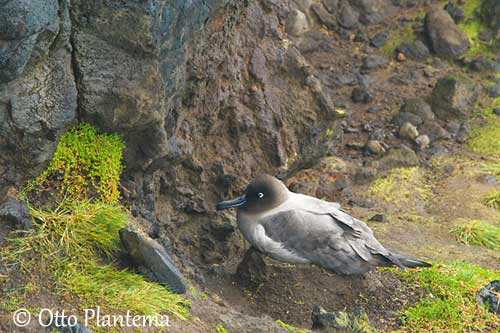
Phoebetria palpebrata
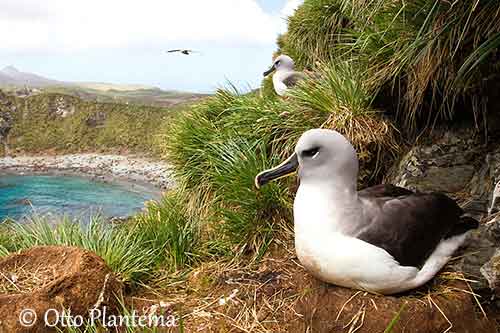
Thalassarche chrysostoma
Only one egg is laid. This large egg needs energy to produce it, and that is why there is no replacement laying and the pair will breed again the following year. The incubation is shared by both adults and lasts 10-11 weeks. They take turns of several days at a time. The stints vary with weather, food availability and distances to the foraging areas, and last in average, three to seven days in the smaller species, and two or three weeks in the great albatrosses.
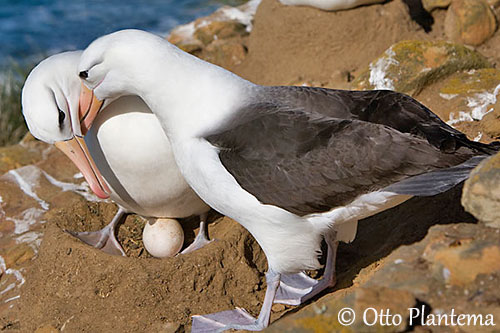
Thalassarche melanophris
These nesting duties continue until the chick is three to five weeks old and does not need to be brooded constantly. While the adults go off to sea for food, the chick remains alone at nest. The parents feed it first almost daily, and soon only every few days. It is fed at the nest-site, but it often wanders freely between two visits. Later, it flies out to sea between the visits. It is fed with partly digested squid and fish, or with stomach oil produced by the adults during their digestion. This oil is rich in fats and allows the chick to wait for food during several days. It fledges between 140 and 170 days after hatching in the smaller albatrosses, and needs up to 280 days in the great albatrosses.
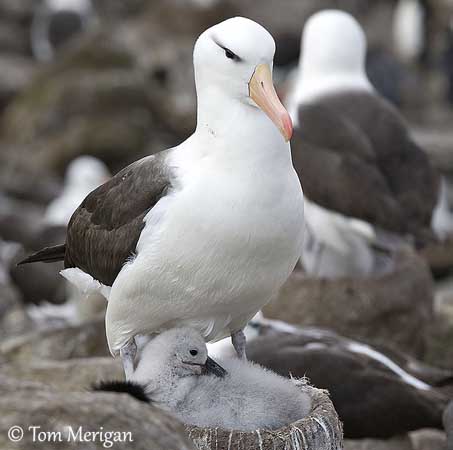
Thalassarche melanophris
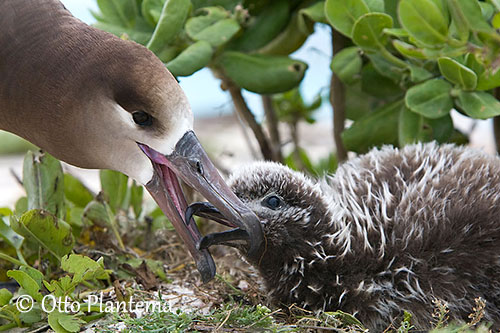
Phoebastria nigriceps
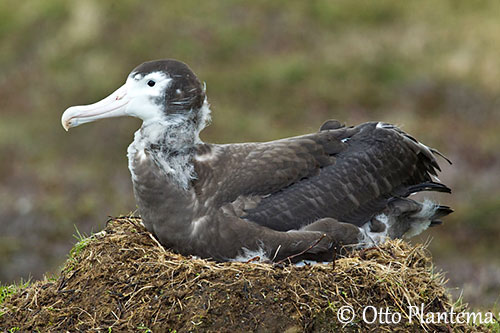
Diomedea exulans
The North Pacific albatrosses disperse widely northwards after the breeding season. As they breed during the local winter, they visit the rich waters of the Bering Sea and the Gulf of Alaska when the waters are well productive. The Laysan Albatross is more abundant in the W Pacific, and the Black-footed Albatross is more common in the E Pacific. The Short-tailed Albatross is usually a regular visitor off the North American coasts, as far south as California after staying in the Bering Sea.
The Waved Albatross which breeds in the Galapagos Islands disperses E to coastal Ecuador and Peru to the rich, cold waters of the Humboldt Current. The species of the Southern Hemisphere disperse widely over the Southern Ocean.
But the migrations may vary according to each species and subspecies, populations, adults and juveniles.
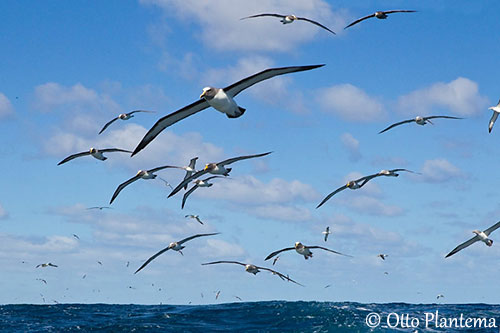
Thalassarche eremita
The albatrosses suffered from the feather trade which developed in the late 19th century. The colonies were raided and all the birds killed all over the world. They also were hunted for food by sailors landing on islands in the Southern Ocean. The eggs were collected too. Collisions of birds and planes on Midway Island in Hawaii in 1959-1963 were a major problem until several arrangements around airports led to the reduction of these incidental collisions.
Today, human persecutions have ceased but disturbances often occur at breeding colonies. The birds are trapped and killed by fishing equipment. Stock of fish, squid and crustaceans are overfished in many areas, reducing the food availability and leading to lower breeding success in several species.
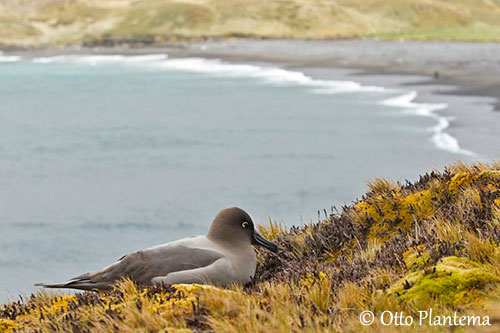
Phoebetria palpebrata
Introduction of predators to breeding islands is a serious threat for albatrosses which nest on the ground. Polynesian Rats (Rattus exulans) and feral cats prey on eggs, chicks and adults, although the birds try to defend themselves by spitting stomach oil onto the intruder or the predator. Oil pollution is not an immediate threat, but near the nesting and feeding areas, it might have a serious impact.
Another problem comes from the ingestion of plastic flotsam. This plastic can be regurgitated for feeding the chicks. It is not the direct cause of the death, but it causes physiological stress. It takes a large place in the gizzard or the stomach and the chick does not feed sufficient quantity of natural food, reducing the chances of survival.
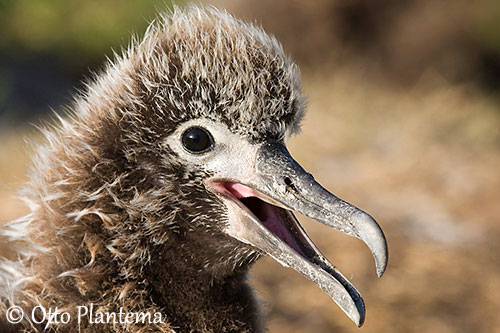
Phoebastria immutabilis
An international effort is needed, with monitoring of the colonies and the complete protection of the birds and their habitat. Human activities resulting in high adult mortality must be reduced too.
In the family Diomedeidae, 7 species are considered as Vulnerable, 5 are Endangered, 6 are Near Threatened and 3 are Critically Endangered. Populations are still decreasing in several areas.
Albatrosses are mentioned in legends, and it was considered unlucky to kill an albatross. To Maori, the albatrosses were the symbol of beauty and power. But the more popular myth is that sailors used to believe that albatrosses were a reincarnation of the soul of a drowned sailor, and to kill an albatross will bring bad luck to the ship and its crew!

Phoebastria nigriceps